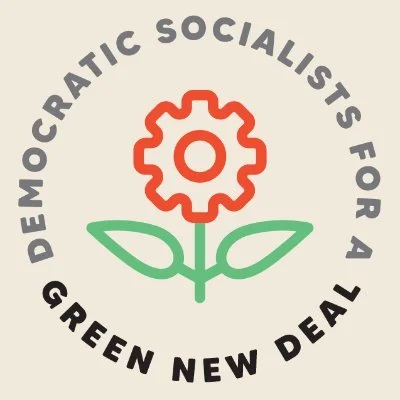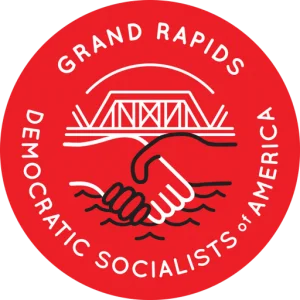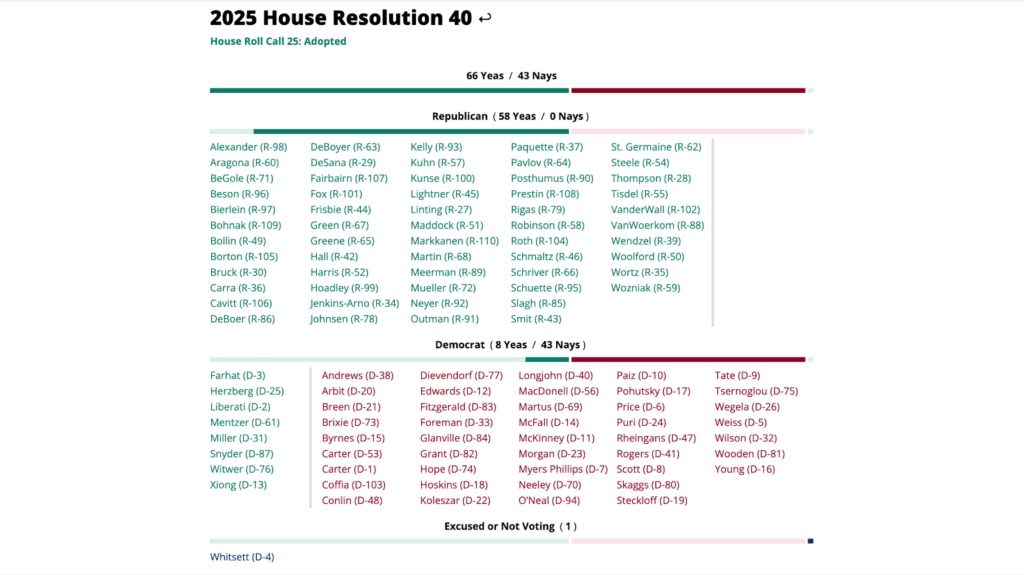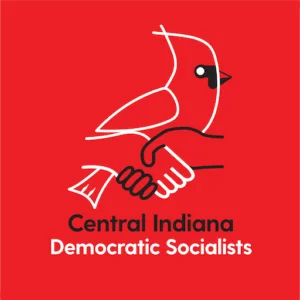


May Day solidarity — Your National Political Committee newsletter
Enjoy your April National Political Committee (NPC) newsletter! Our NPC is an elected 18-person body (including two YDSA members who share a vote) which functions as the board of directors of DSA. This month, join May Day actions, protect trans rights, get involved with our national Convention, and more!
And to make sure you get our newsletters in your inbox, sign up here! Each one features action alerts, upcoming events, political education, and more.
- From the National Political Committee — May Day Solidarity
- National Electoral Commission Announces Two New Candidates — Your Support Can Put Them in Office!
- Help Pass Vital Trans Rights Legislation Today!
- Fight Oligarchy This May Day! Mass Call Sunday 4/29, Marches Monday 5/1, Thursday 5/3
- Monthly Convention Update: Volunteering Opportunities, Proposal Submissions, and Convention Programming Submissions Open!
- Sign Up for Housing Justice Commission’s May Meeting Wednesday 5/7
- Protect Socialist History! Join Our DSA Archives Workshop Thursday 5/29
- The Afrosocialists and Socialists of Color Caucus is Stronger and Building!
- Apply for DSA’s National Communications Committee
From the National Political Committee — May Day Solidarity
May Day is a uniquely international holiday, where workers of the world unite to celebrate our history and demands for our future — and it’s a holiday with deep American roots. A May Day 1886 protest demanding 8-hour work days (something we so often take for granted) led to the Chicago police brutalizing a crowd of protestors in Haymarket Square, and a series of violent events which led to the unjust state executions of 7 “Apostles of Labor.”
Socialists must remember these roots. This fight has never been easy, but we stand on the shoulders of giants, arm in arm with our comrades across our own organization — over 70,000 strong — and our siblings in the labor movement, the renters’ rights movement, the Palestinian liberation movement, the migrants’ rights movement, and so many more.
Because of this solidarity, we have incredible opportunities to organize and exert our collective strength, working locally and nationally in unison with mass movements around the world, to pick big fights against the boss class, and to win. We are stronger every day, even as the forces of capital work to slow us down, because we continue to build this solidarity.
We’ve witnessed the strength of this solidarity in the last few weeks, as hundreds of thousands of people have come out to the “Fighting Oligarchy” tour to see democratic socialists like Bernie Sanders and Alexandria Ocasio-Cortez speak out against the system that oppresses us, even in deep red parts of the country like Idaho and Bakersfield, California. The rallies feature labor organizers representing people who form the backbone of our economy, from rideshare workers to farmworkers, and socialist electeds building the bench downballot, like DSA city councilmember Eunisses Hernandez in Los Angeles. The message is clear: a better world is possible, and we need class solidarity to win it. DSA members are showing up in force at local stops of this tour to canvass attendees and show how we are ready to give people the chance to be protagonists of their own history and build the working class power we need at scale to take on the oligarchy.
DSA chapters all across the country are planning May Day events, and we have officially joined the May Day Strong movement, organized with the Chicago Teachers Union and Bargaining for the Common Good. We’re encouraging DSA members everywhere to plug in — check out our May Day toolkit for ways to get involved. You can find your nearest chapter and their contact info here, and check the May Day Strong Map to find an event near you!
This year, mobilizing on May Day is even more urgent:
- In spite of the objections of the Supreme Court, members of Congress, and millions of working class people, Kilmar Abrego Garcia, a father and union worker, is still being detained illegally in El Salvador.
- Pro-Palestine organizer and former UAW member Mahmoud Khalil is being held illegally in ICE detention in Louisiana.
- Over two hundred thousand federal workers have lost their jobs and nearly a million more have been told that their right to bargain over working conditions no longer exists.
And before you hit the streets on May 1, please join us for a mass call on April 29. On this call — Fight Oligarchy: Build to May Day 2025 — you’ll hear from labor organizers, immigrants’ rights activists, and DSA chapter leaders on how you can fight back this May Day against attacks on our unions, rights, and essential services.
Need more ways to plug in? Please scroll down for a number of exciting ways to organize today — several of our national committees are seeking new members, we have a call to action from comrades in Colorado against an anti-trans bill, there’s more info about DSA Convention 2025 (to be held in Chicago, the Haymarket Martyrs’ resting place), and lots more ways to tap in and fight for a better future.
This is a difficult moment in our history, but the bosses are scared. They haven’t seen an organized left of this strength and caliber in their lifetimes. The stakes are high, and it’s on us to organize with even more strength and purpose, to exploit the contradictions that open up in uncertain times like these, and to win. May Day is a day to remind each other that together, organized people make history.
In Solidarity,
Megan Romer and Ashik Siddique
DSA National Co-Chairs
National Electoral Commission Announces Two New Candidates — Your Support Can Put Them in Office!
This year, DSA’s National Electoral Commission has an exciting new project. We’re supporting a rotating slate of candidates with nationwide fundraising throughout the year — and in our first 30 days, we’ve already raised over $20,000!
We couldn’t be prouder of this slate of socialist candidates. All of them represent DSA and our vision for the future so well, including our two latest new endorsees, Tammy Honeywell and Michael Westgaard. Tammy Honeywell, a union leader and founding member of Syracuse DSA, is running for a seat in the Onondaga County Legislature in upstate New York. And in Washington State, Michael Westgaard of Seattle DSA is running for Renton Common Council. Your donations can help put them and our socialist candidates across the country in office!
And do you want to help out with phonebanking? Sign up for the NEC email list for more info!
Help Pass Vital Trans Rights Legislation Today!
URGENT ACTION NEEDED! The Kelly Loving Act (HB25-1312), a bold package of pro-trans changes to Colorado law backed by Colorado DSA chapters, has passed the State House and is currently before the State Senate. However, far-right opposition is mounting, and we need your help to get this vital trans rights legislation across the finish line! Click here to write to Colorado legislators and demand they take action to protect trans people.
Fight Oligarchy This May Day! Mass Call Sunday 4/29, Marches Monday 5/1, Thursday 5/3
The Trump administration continues to target federal workers, immigrants and the institutions that provide basic support for working people in our country. On May 1st, chapters across the country are joining the call to fight back and build a movement that can fight for the world we deserve!
Join us this Sunday, 4/29 at 8:30pm ET/7:30pm CT/6:30pm MT/5:30pm PT to learn how you can be part of this fight. On this call, you’ll hear from organizers fighting for immigrant rights, defending our federal services, and building cross-union structures to build to May Day 2025!
Monthly Convention Update: Volunteering Opportunities, Proposal Submissions, and Convention Programming Submissions Open!
Our DSA Convention is coming up in August, and preparations are going on now. To start, we have openings on Convention Planning Subcommittees! The Convention Planning Subcommittees are looking to fill a few open spots. Interested members can view more information and apply to join a Convention Planning Subcommittee here! The application deadline is Friday, 5/2.
And proposals have been flying into our Convention Hub on the DSA Discussion Forum. These include new Bylaws, Platform Changes, and Resolutions, all of which are looking for signatories. Head on over to the Convention Hub to see what’s being submitted and sign on to things you want to see debated on the Convention floor! The deadline to submit proposals is Sunday 5/11.
You must be a member in good standing to view and sign on to any proposals. If you need to sign up for the DSA Discussion Forum account, go here to make your account today!
Having trouble getting on the forum? Reach out to the NTC at ntc@dsacommittees.org.
We’re also excited to open our call for submissions for programming sessions at this year’s DSA National Convention. You can submit your ideas here until Saturday, May 31. Sessions can include workshops, panel discussions, seminars, and creative displays or performances. This year, we are aiming for diverse, engaged, and energetic programming that connects to our theme, “Rebirth and Beyond: Reflecting on a Decade of DSA’s Growth and Preparing for a Decade of Party-Building.”
And finally, DSA’s National Fundraising Committee is calling for new members to help us raise a boatload of money to support DSA’s work at the 2025 DSA National Convention. We’re particularly looking for help organizing a live fundraiser event on Saturday, August 9. This includes soliciting donations of auction items for our live auction. If you have chapter fundraising experience, that’s all the better, but anyone can help contribute to this work. Apply here today! Applications are open on a rolling basis.
Sign Up for Housing Justice Commission’s May Meeting Wednesday 5/7
Join the Housing Justice Commission’s May meeting on Wednesday 5/7 at 8pm ET/7pm CT/6pm MT/5pm PT! On this call, you’ll hear about our consensus resolution for the 2025 DSA convention, and our new and improved Emergency Tenant Organizing Committee project. If you’re interested in starting a new tenant union or you want to talk about housing work in DSA, come on through!
Protect Socialist History! Join Our DSA Archives Workshop Thursday 5/29
DSA Archives Workshop is BACK! When socialist education is under attack, what do we do? Stand up, fight back… by taking care of our history and records! After a long hiatus, NPEC is excited to bring back the DSA Archives Workshop, co-sponsored by the DSA Fund. Chapter secretaries, political educators, comrades with old stuff, and anyone interested in the importance of archives for the left are welcome to join! The call will be held on Thursday, 5/29 at 8pm ET/7pm CT/6pm MT/5pm PT. RSVP here today.
The Afrosocialists and Socialists of Color Caucus is Stronger and Building!
Thanks to everyone who joined our 4/10 General Body Meeting — our first since relaunching with the new Executive Committee! We’re now forming Working Groups and Committees to kick off organizing efforts and internal support structures.
Want to plug in? Fill out the interest form to help lead or join a group. Groups with the most engagement will be prioritized.
Apply for DSA’s National Communications Committee
The National Communications Committee is expanding! We are looking for DSA members with experience in video editing, livestream production, social media strategy, graphic design, media relations, and more to expand our national communications work. The National Communications Committee’s NPC members and at-large co-chair will appoint the new members, and will be accepting applications on a rolling basis. Apply here today!
The post May Day solidarity — Your National Political Committee newsletter appeared first on Democratic Socialists of America (DSA).



2025 GNDCC Priority Committee Resolution
Whereas the existential threat of the global climate and ecological crisis we face, unlike any in human history, requires socialists to make this a central terrain in our struggle for a better world and against a racialized capitalist system profiting from extraction, exploitation, and domination.
Whereas the Green New Deal (GND) is a flexible and popular framework for transformative state climate and environmental action, not a particular bill or predetermined set of policies.
Whereas, DSA adopted resolutions in 2019, 2021, and 2023 to prioritize fighting for an ecosocialist Green New Deal as defined by DSA’s democratically adopted GND Principles;
Whereas in 2023, the GNDCC launched the Building For Power (B4P) campaign to train and support DSA chapters to fight for state and municipal GND-style reforms in coalition with unions and other mass working-class organizations behind a common vision of an emancipated, democratic, and sustainable society;
Whereas, the GNDCC has provided dozens of trainings, workshops, mass calls, webinars, and policy briefs for at least 85 chapters in support of the B4P strategy;
Whereas, chapters around the country have adopted B4P campaigns and successfully built significant relationships with organized labor and propelled socialists in office, including Milwaukee’s Power to the People, Chicago’s Fix the CTA, Louisville’s Get on the Bus, NYC’s House the Future, and more;
Whereas, the GNDCC, as all national bodies, has submitted a report going into further detail on activity within the past two years;
Whereas by coaching chapters to run B4P campaigns, the GNDCC can help build DSA’s capacity to respond to a second Trump administration by developing strong chapters that can execute strategic campaigns;
Be it therefore resolved the GNDCC is rechartered as a national DSA priority commission until the 2027 DSA Convention, and is tasked with continuing its work training, coaching, and supporting chapters with Building for Power campaigns.
Resolved that the GNDCC will continue to train and organize DSA chapters to run and win legislative campaigns and labor and ballot demands for reforms that shift structural power to the working class by building public sector and organized labor capacity—like expanded mass transit, democratized and decarbonized public energy, green social housing, and green public spaces and facilities.
Resolved that the GNDCC will continue to support the development of chapter capacity by providing campaign-oriented training, coaching, resources, and educational materials and facilitating cross-chapter coordination as part of a larger unified strategy.
Resolved that the GNDCC will continue to emphasize collaboration with other DSA national bodies on overlapping campaign and policy areas, especially via mass political education events. Specifically, GNDCC will work with the NPC’s Trump Administration Response Committee (TARC) to incorporate, where strategic, B4P and the GNDCC’s ongoing work into the messaging and tactics of DSA’s national response to the Trump administration.
Resolved that the NPC will appoint the 11-member GNDCC within 60 days of the start of the NPC term, to serve a term of two years until the 2027 National Convention. The outgoing GNDCC will solicit applications and the NPC will appoint candidates based on the capacity, skills, and knowledge needed for carrying out this campaign.
Resolved that the GNDCC will maintain such subcommittees and processes as needed to fulfill the campaign’s objectives.
Resolved that the NPC will commit resources to the work of the campaign, particularly coaching, training and growing DSA chapters engaged in work within its umbrella. Such resources shall include, at least, the following:
- Staff, technical, and other support for campaign fundraising and merchandise, as reasonably needed and requested by the GNDCC;
- Budget funds necessary to support digital tools and resources for campaign organizing;
- Access to DSA member data and other resources as reasonably needed and requested by the GNDCC.



This Month — Fight Fascism, Build to May Day
Our National Labor Commission is fighting fascism and building worker power! Throughout April, we’re building up to International Workers’ Day. This week, join us at two events to kick this off:
- Mass call with the Chicago Teachers Union (CTU) on Thursday 4/3 at 5pm ET/4pm CT/3pm MT/2pm PT
- Saturday, 4/5 Hands Off! in-person actions against fascism across the country
International Workers’ Day is also known as May Day. On May 1, 1886, during a period of extreme wealth inequality, social oppression, and political corruption, hundreds of thousands of workers across the US withheld their labor and took to the streets in a general strike against industrial barons, demanding an eight-hour work day.
Nearly 140 years later, unelected billionaire oligarchs like Elon Musk are seizing control of our government. The bosses are using state power against the working class to suppress opposition, consolidate power, and destroy our ability to fight for a better life.
But working people aren’t going anywhere. DSA Labor is building power for the short and long term, not only to stop authoritarianism but to transform our society into one in which workers are in the driver’s seat. We need you to join us in building towards May Day 2025, May Day 2028, and beyond.

Here’s how you can join us to fight oligarchy and build up to this year’s International Workers’ Day.
 Thursday, 4/3, 5pm ET/4pm CT/3pm MT/2pm PT: CTU National Call for May Day 2025
Thursday, 4/3, 5pm ET/4pm CT/3pm MT/2pm PT: CTU National Call for May Day 2025
Join the Chicago Teachers Union (CTU) and friends for a national mass call to learn how to build May Day 2025 to be as big and powerful as possible.
 Saturday, 4/5: “Hands Off” National Day of Action
Saturday, 4/5: “Hands Off” National Day of Action
Join a growing nationwide coalition of labor and community partners to say: Hands off our democracy, our rights, our livelihoods, and our neighbors!
 Tuesday, 4/8: “Kill the Cuts” National Day of Action
Tuesday, 4/8: “Kill the Cuts” National Day of Action
Stand in solidarity with workers in education, research, and healthcare to demand NO cuts to education and life-saving research.
 Sunday, 4/13, 8pm ET/7pm CT/6pm MT/5pm PT: Building Sanctuary Unions Training Session
Sunday, 4/13, 8pm ET/7pm CT/6pm MT/5pm PT: Building Sanctuary Unions Training Session
DSA’s National Labor Commission has partnered with DSA’s International Migrant Rights Working Group to host member training sessions. Learn how to organize within your union for an American labor movement where immigrant workers can find protection and build power.
 Tuesday, 4/29: Fight Oligarchy, Build to May Day Mass Call
Tuesday, 4/29: Fight Oligarchy, Build to May Day Mass Call
Join us as we gear up for May Day 2025! We will hear from labor organizers, immigrants rights activists, and chapter leaders about why workers everywhere need to stand up and fight back against the attacks on our unions, rights, and essential services, and how you can join in the fight today and in the weeks and months ahead.
 Thursday, 5/1: May Day 2025
Thursday, 5/1: May Day 2025
Save the date to join hundreds of thousands in the streets for International Workers’ Day.
And our next quarterly “Workers Organizing Workers” Training starts on Monday 4/7 at 8pm ET/7pm CT/6pm MT/5pm PT! This three-part training series is great for anyone interested in getting a job and organizing in a strategic industry. The training covers the basics of finding these positions, talking to coworkers, and being part of a movement to bring workplace democracy to some of America’s largest employers.
If you’d like to get more involved with the National Labor Commission, the body of DSA members active in the labor movement, apply here! We have opportunities for members interested in strike support, Palestinian solidarity, educator organizing, and more!
The post This Month — Fight Fascism, Build to May Day appeared first on Democratic Socialists of America (DSA).


Call your Reps and Tell Them to Let Trans Kids Play Sports
On March 12th, eight state Democrats in Michigan voted for an anti-trans resolution that would hurt trans kids in schools.
HR40 is a non-enforceable resolution that strongly encourages the Michigan High School Athletic Association to discriminate against trans women by following Trump’s executive order to ban trans-women in women’s sports.
Despite it being non-enforceable, this resolution would lead to increased harassment and discrimination towards trans children who just want to play sports with their classmates.
The eight state Democrats who voted for this resolution are Rep. Alabas Farhat, Rep. Peter Herzberg, Rep. Tullio Liberati, Rep. Denise Mentzer, Rep. Reggie Miller, Rep. Will Snyder, Rep. Angela Witwer, and Rep. Mai Xiong.

Call your state Representative and let them know how you feel about their vote! You can find your state Representative here!
If your state Representative voted yes for this resolution, call them to express how disappointed you are and tell them they need to stand for trans rights or you will be voting against them in the next election.
If your state Representative voted no for this resolution, call and thank them for siding with trans people. Encourage them to continue their support and to speak up for the rights of trans people. We need as many people in positions of power to be on our side.
Keep in mind, your state representative does not represent anywhere close to as many people as your US Congress representative. Your call could very well sway them to support trans people going forward, even if they are Republican. In Montana, 29 Republicans changed their mind on an anti-trans bill after Reps. Zooey Zephyr and SJ Howell gave impassioned speeches. This goes to show that it is possible to sway state Republicans.
The whole situation was handled so maliciously. Speaker Pro Tempore Rachelle Smit (R-43), a far-right Republican who believes the 2020 election was stolen from Trump, kept cutting off the speeches of Democrats so that her Republican colleagues could speak. The vote was then rushed through the House without letting Democrats finish their speeches. Erin in the Morning provides a copy of the whole situation here.
We must all stand for the rights of trans people!
The post Call your Reps and Tell Them to Let Trans Kids Play Sports appeared first on Grand Rapids Democratic Socialists of America.


Your National Political Committee newsletter — Fascism is Capitalism in Decay
Enjoy your March National Political Committee (NPC) newsletter! Our NPC is an elected 18-person body (including two YDSA members who share a vote) which functions as the board of directors of DSA. This month, get involved with the Mutual Aid Working Group, join AfroSoC, apply for the Growth & Development Committee Steering Committee, and more!
And to make sure you get our newsletters in your inbox, sign up here! Each one features action alerts, upcoming events, political education, and more.
- From Our Co-Chairs — Fascism is Capitalism in Decay
- Growth & Development Committee Steering Committee Application: Open Through 4/1
- State of DSA Reports — Listening Session #2
- MAWG All Members Meeting for Spring 2025
- AfroSoC is BACK with a New Executive Committee!
- Extension of National Political Education Committee Application Window
- Apply for the National Budget & Finance Committee
- Fundraising Committee Office Hours
From Our Co-Chairs — Fascism is Capitalism in Decay
“Society does not consist of individuals, but expresses the sum of interrelations, the relations within which these individuals stand.” – Karl Marx, The Grundrisse, 1857
Jumping headlong into dialectical and historical materialism might not be the usual theme of our newsletters, but in this era of cartoon supervillians like Donald Trump and Elon Musk, we think it’s worth remembering that, while these Uncle Pennybags caricatures are the most prominent faces launching “shock doctrine” attacks on our already tattered social safety net, they are simply extra-vulgar representatives of the forces of capital that have always been exploiting and oppressing the working class.
In many ways, it’s useful to point to Elon Musk, an unelected billionaire and the richest man in the world, hooting and hollering his way through the dissolution of our children’s schools and our parents’ social security. He makes the contradictions of capitalism clearer and more terrifying than they have been in our lifetimes. While Musk initially seemed to offer a liberal, technocratic, very online veneer to the ascendant new green tech sector of capital, socialists called bullshit years ago on this union-busting capitalist. The mask has now come off. Musk is a scion of global apartheid, as he makes explicit his sympathies with fascism that justify the large-scale labor exploitation and imperialist resource extraction that underlie his super-profits.
As socialists, we are disgusted to see so little pushback to Trump’s amped-up second-term agenda from their neoliberal capitalist political “opposition” in the Democratic Party, nor from the donor-controlled institutes of higher education that are rolling over one by one to hand over students like Mahmoud Khalil to ICE thugs, nor from the hospitals that are pre-emptively refusing gender-affirming care for our community members who are in genuine need. We must remember that, for all the grotesque buffoonery that Musk and Trump (and their rogue’s gallery) put on display, when it comes down to it, they’re representing their class interests, and the ruling class at large seems to be just fine with it.
Fascism is capitalism in decay, and November’s election peeled off a bandage that covered a bone-deep rot. But as socialists, we know the cure. The working class is the agent of change. We outnumber the capitalists (and the goons who do their dirty work in institutions of power) by orders of magnitude, but we can only fight back if we’re organized in huge numbers across capitalism’s forced divisions, and that’s what we’re doing. While Democratic Party elites suggest it’s time to stand down, we know we must fight for full-throated demands by ordinary people for everything we need not just to survive, but thrive.
DSA chapters across the country are working alongside the Federal Unionists’ Network to organize federal workers to push back against the dismantling of their various agencies. We’re showing up in city council meetings to demand that sanctuary laws be passed to protect queer and trans members of our community. We’re standing with teachers and postal workers across the country to fight for education and the right to access information, and to protect and expand good union jobs. We’re fighting back against hospitals as they refuse to offer gender-affirming treatment and we’re demanding that universities across the country offer safe learning environments where students don’t have to fear being snatched by ICE.
Our solidarity doesn’t stop at our borders, either; we continue to fight for Palestinian liberation and safety, against escalating military action in Yemen, against expansion of US military bases across the Pacific, against unjust embargoes that punish the working people of countries around the world, and alongside our comrades everywhere as they organize antifascist strategies for mass politics against a globally-ascendant right wing.
We are proud to be among the convening organizations of the National March on Washington on April 5 to stop the US-Israeli genocide in Gaza — join us in DC if you can! The moment could not be more critical, and it is our responsibility to fight back against the Trump administration’s attempts at repression and come out in massive numbers.
We are stronger when we are organized, and that means putting ourselves into motion to fight for common socialist goals. It means organizing our time, our talents, and our resources. It means honing ourselves into socialist organizers who are ready with strong analysis and the organizing tools to put that analysis into real on-the-ground wins. It means building an enormous, strong, and flexible political instrument that’s ready to take on the capitalist class on every terrain: at the ballot box, the workplace, our homes, our broader communities, and the streets.
If you’re not plugged into your DSA chapter yet, we encourage you to get involved today, whether it’s offering your time and skills to local work or a national committee (lots of fresh opportunities for the latter are below!), running for delegate for DSA’s biennial convention this summer, or even simply increasing your dues payment by a few dollars per month to help keep our organization stable and funded.
We will see you in the fight!
Growth & Development Committee Steering Committee Application: Open Through 4/1
The Growth & Development Committee is seeking new applicants for its Steering Committee! Nine member leaders will be appointed by the National Political Committee to direct GDC’s work guiding membership growth, retention, chapter support, training and more. Applications will be open until 11:59pm PDT April 1st. Apply here.
State of DSA Reports — Listening Session #2
The Growth and Development Committee is launching a series of Listening Sessions as part of its State of DSA Reports project to bring organizers together to share experiences, reflect on our victories, and identify ways to tackle the challenges we all face.
Our second session is Thursday April 3rd at 8:30pm ET/7:30pm CT/6:30pm MT/5:30 PT, and will focus on activation and politicization. Once a member is engaged, what does continual development look like in your chapter? We’ll be talking through political education, leadership development, and democratic processes — come tell us what you think!
MAWG All Members Meeting for Spring 2025
DSA’s Mutual Aid Working Group (MAWG) has returned! We are here to help members and chapters organize mutual aid projects and offer our guidance with incorporating into the organizing work already happening across DSA. We believe in mutual aid as a positive force within DSA’s organizing work and hope to see it play a larger role in our impact as an organization. Our first all-member meeting of the year is coming up on Thursday April 3rd at 8:30pm ET/7:30pm CT/6:30pm MT/5:30pm PT! New and returning members are welcome as we discuss the future of mutual aid in DSA and hear from members on how MAWG can be of help!
AfroSoC is BACK with a New Executive Committee!
On February 28th, with 46 votes cast, the AfroSoC Caucus elected a new Executive Committee for 2025! Congratulations to Ciné J., Mary B., AJ W., Abel A., Syjil A., Jane M., Christopher W., Michael G., and Nxongotelo M. on their leadership!
Are you a BIPOC DSA member looking to engage with AfroSoC? Get involved by filling out our interest form to join our Slack, enlisting your local AfroSoC chapter, or signing up for a Working Group or Committee to help rebuild our national activities. Plus, don’t miss our Quarterly General Body Meeting on Thursday 4/10 at 7pm ET/6pm CT/5pm MT/4pm PT — Zoom link coming soon!
Extension of National Political Education Committee Application Window
The National Political Education Committee is seeking members with experience as educators both inside and outside of DSA to help us expand our national political education programs and provide chapters with up-to-date resources for their own local programs. We have extended the previous application deadline to April 6th, and encourage you to apply and pass the application along to your chapter’s poli-ed and/or communications team, as well as comrade-educators in your circles. Please see the application form for further details. If you have any questions or concerns, feel free to reach out to the Political Education Committee at politicaleducation@dsacommittees.org.
Apply for the National Budget & Finance Committee
DSA’s National Budget & Finance Committee is seeking applicants to fill a limited number of seats on the committee. Applications are due by April 7, 2025.
Budget & Finance is the national committee that works with the national Treasurer and staff to oversee our financial strategy, guide the NPC and Convention in allocating resources, and ensure transparency in our budgeting processes. It is a small working committee made up of members who have special interest or expertise in financial matters, budgeting, and related topics. The committee is currently starting work on the 2025 budget and planning for our next national convention.
Meetings are weekly, currently on Tuesdays at 5:30 ET. Due to the importance and specific required expertise for this work, potential committee members will be screened for credentials, background, and experience. If you’re a numbers nerd, current or ex-chapter treasurer, or have other finance/budgeting experience through DSA or externally, we encourage you to apply!
Fundraising Committee Office Hours
Join DSA National Development Director Tiffany and members of the Fundraising Committee on Tuesday, April 8th, 7:30pm ET/6:30pm CT/5:30pm MT/4:30pm PT for Fundraising Office Hours! We’ll keep a call open for any chapter leaders to ask questions about fundraising, including how to get ready for the 2025 DSA National Convention and how to support your chapter’s local work. Sign up here.
The post Your National Political Committee newsletter — Fascism is Capitalism in Decay appeared first on Democratic Socialists of America (DSA).



